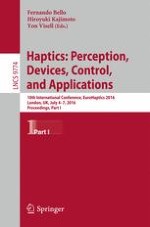2016 | Book | 1. edition
Haptics: Perception, Devices, Control, and Applications
10th International Conference, EuroHaptics 2016, London, UK, July 4-7, 2016, Proceedings, Part I
Editors: Fernando Bello, Hiroyuki Kajimoto, Yon Visell
Publisher: Springer International Publishing
Book Series : Lecture Notes in Computer Science
